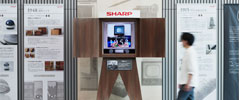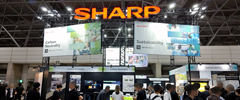Sharpfax SF-201, Released in 1972, Certified as a Copying Machine Heritage
July 24, 2024
I am M in charge of product planning for multifunction printers (MFPs) at Sharp.
Sharp’s first copying machine, the Sharpfax SF-201, released in 1972, has been certified as a “Copying Machine Heritage” in Japan.
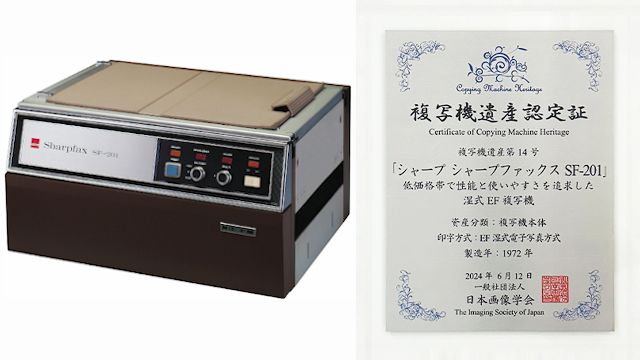
Sharpfax SF-201 and certificate
The Copying Machine Heritage was established in 2018 by the Imaging Society of Japan*1 as a certification system to honor the technical and social achievements of early copying machines, which were the driving force behind the development of Japan’s copying industry, and to pass them on to future generations as cultural heritage.
This time, I interviewed Mr. N, my master who has been involved in the development of multifunction printers for many years and worked hard to obtain this certification.
(Ms. M)
What initially prompted our company to develop the copying machine?
(Mr. N)
In 1964, Sharp commercialized its first calculator, which contributed to office work efficiency. However, our sales team gave feedback that we need to merchandise copying machines as well to further promote office automation. Based on such demands, in 1969, Sharp’s Development Division, Industrial Equipment Unit was established.
(Ms. M)
What was the development system and the state of development at that time?
(Mr. N)
A total of six people (average age 28) gathered at the Nara No.1 Plant in Yamato-koriyama City, Nara Prefecture: three in charge of mechanical unit development, one concurrently in charge of tracing and general affairs, and two new employees. Development began in 1970.
The SF-201 that received certification was a wet CPC (Coated Paper Copier) copying machine known for its EF (Electrofax) electrophotographic system, and with no one in the company with experience, it was a completely new manufacturing challenge.

(Ms. M)
It is easy to imagine how difficult it must have been to develop a new field. How was it with regard to production?
(Mr. N)
The first shipment was set for January 6, 1972, and production of 50 units began in fall of 1971.
Although issues occurred just before the completion of production of the planned number of units, fortunately, the problem was not serious, and production of the planned number of units was completed in time for the first shipment.
(Ms. M)
I understand many obstacles in both development and production were overcame to bring the product to market. How was the reputation of SF-201 in the market?
(Mr. N)
As stated in the brochure at the time, unique features such as fastest copy speed (at that time) of 10 sheets of A4 format per minute and easy to use operation panel for easy check were well received, and over the next following four years, more than 10 different models of the SF series were released. This was the result of our ability to understand the needs of our customers and create products with unique features, even though we were a latecomer to the copying machine business.
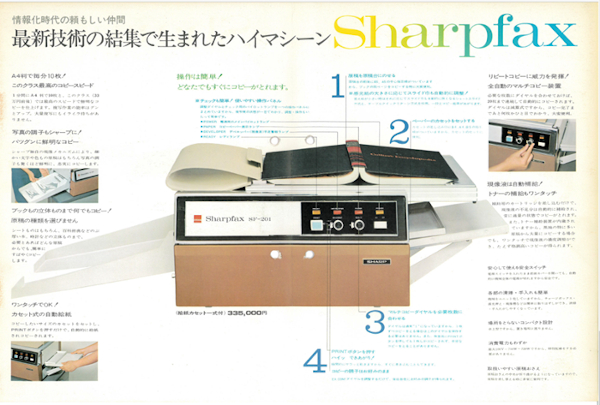
Brochure of the time
(Ms. M)
Were there any innovations unique to our company in sales approach too?
(Mr. N)
It seems cultivating sales channels was very difficult, and even our President Saeki at the time made top sales negotiations by himself. Under such circumstances, the company adopted a credit system which was rare among office equipment manufacturers at the time. By combing such sales efforts with our unique product, the company sold approximately 1 billion yen in the fiscal year ended September 30, the third year after the release of the copying machine.
(Ms. M)
So, we were able to establish our position as a copying machine manufacturer despite being a latecomer to the market.
(Mr. N)
That’s right. With the momentum we gained, we foresaw the era of plain paper copy (PPC: Plain Paper Copier) market coming, and decided to develop a dry-type PPC copying machine as well.
As a result, in 1974, two years after the release of our first model SF-201, we launched our first dry-type PPC copying machine, SF-710. A magazine at the time related to us as a “reliable newborn baby” for the early launching of the SF-710 dry-type PPC copying machine, despite being the last to go on the market, showing how surprised people were in our sudden development.
(Ms. M)
I see. So, the MFPs we use today began in this era?
(Mr. N)
The first dry-type PPC copying machine was introduced in the U.S. in 1959. Japan entered the era of dry-type PPC copying machine around the early 1970s.
The SF-710 was the industry’s first electronically controlled copier adopting IC circuitry in the control unit. In this way, Sharp introduced a series of multifunctional copiers that were equipped with many industry-first technologies.
(Ms. M)
I understand. Such spirits have been passed on to the unique features of our MFPs, such as the integrated retractable keyboard and the large 10.1-inch color LCD Touchscreen. To further ensure that our products can be used with peace of mind, in 2001 we became the first in the industry to receive Common Criteria (CC) *2 certification. I believe this expresses how much we cared about security as well.
A Full-size Retractable Keyboard
In 2008, this keyboard was made available as an option for the MX-2600FN and MX-3100FN, and has continued to be offered as an option for various models since then. This keyboard facilitates the input of file names and addresses when sending scanned data by e-mail, for example.

Large 10.1-inch color LCD Touchscreen
In 2010, the large 10.1-inch LCD Touchscreen was installed in three digital full-color MFP models MX-3610FN, MX-3110FN, and MX-2610FN released. It enables a variety of new functions, including gesture operation such as flicking, which has become popular along with smartphones, the ability to display and check an imported document on a large screen, and the ability to access a Web page directly without a PC and print the displayed image (optional).
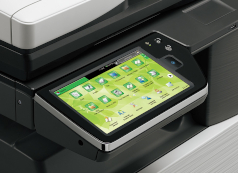
(Mr. N)
That’s right. All of these functions and features were created through product development from the customer’s perspective.
In addition to these functions and features, the design of our products deriving from us being a home appliance manufacturer have also been highly evaluated. The design that evokes a wind pattern, which is still carried on today, enables the product to fit in any environment. Furthermore, the fact that our MFPs currently have the largest market share*3 in Japan for installation in convenience stores shows that our aim is to create machines that are easy to use for all kinds of users, and not just office workers.
A Design that evokes a wind pattern
The four models of the MX-2600/3100 series released around 2008 added a unique texture that evokes a “wind pattern” not seen in conventional MFPs. The design expressed our desire to be a people-friendly business partner that fits in with a variety of spaces.

(Ms. M)
It is encouraging for us at the Planning and Development divisions with such unique Sharp products being recognized as a Copying Machine Heritage.
(Mr. N)
It truly is. With this SF-201 certification, I hope our copying machines and MFPs can be widely introduced as our heritage with a historical significance.
Currently, we are looking for information if anyone has any of our products from the time our copying machines business was founded (around 1972 to the 1980s). Please contact us at the address below. We will be happy to hear your stories about those days.

Contact Desk for Receipt of Information on this matter:
progress_of_sdb@mail.sharp
(Ms. M)
Thank you very much. I was able to learn about the history of our company’s copying machines from our seniors.
Inheriting the thoughts of our predecessors, I would like to deepen my understanding of their ideas and our unique and distinctive past products, and continue to plan products that will be close to people and cherished.
*1 The Imaging Society of Japan(ISJ) is a group of engineers and researchers who exchange information on the fundamentals and applications of images, aiming to advance and develop imaging technology, and who provide a variety of forums for the exchange and absorption of information on imaging science and technology and related fields. For more information, please visit the Imaging Society of Japan website.
*2 Common Criteria(CC)
An international standard that defines criteria for evaluating the security of information equipment, information systems, etc. Since 2000, we have been working on data security for multifunctional digital copiers.
In April 2001, the “Data Security Kit” for MFPs sold in the U.S., AR-FR1/2/3, received “Common Criteria EAL2” certification from a U.S. certification organization, the first in the MFP and printer industry.
The kit ensures a high level of security by encrypting all electronic data for copying, printing, faxing, and scanning, and by erasing data after output and transmission processes.
*3 As of July 24, 2024; based on Sharp findings.
Product Information
https://jp.sharp/business/print/(Japanese)
Press Release
Sharpfax SF-201, released in 1972, certified as a Copying Machine Heritage
The birth of Sharp copiers
https://global.sharp/products/copier/anniversary/heritage/
